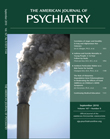Response to Amen Letter
To the Editor: We appreciate the opportunity to respond to the points Dr. Amen raises. Since we have made major professional and research efforts to investigate the use of imaging modalities for psychiatric diagnosis and treatment, we are acutely aware of the need to assure that any clinical tool, particularly those used in children, must be supported by empirical evidence.
As noted in our letter as well as in the book review by Leuchter (1), there is presently no evidence to support neuroimaging techniques to aid, substantiate, or otherwise illuminate the diagnosis or treatment of psychiatric disorders. The references offered by Dr. Amen do not suggest otherwise. Camargo (2) notes that “Brain SPECT in psychiatric disorders is still investigational. Despite considerable research interest in this area, specific patterns of the various diseases have not been definitely recognized.” Although Carmago goes on to state that “perfusional and receptor imaging findings may be used as an additional diagnostic tool to guide clinicians searching for a definite diagnosis,” no validated examples of this approach were provided. Brockman et al. also did not advocate the use of SPECT in clinical practice. In fact, Brockman et al. (3) specifically noted that the use of SPECT in predicting treatment response “is beyond the sensitivity of this method.”
Dr. Amen's own publications do not support the use of SPECT imaging in assisting with the diagnosis or treatment of psychiatric disorders. His study of patients with completed suicide includes only 12 subjects (4). His retrospective study of 157 patients showed that regional cerebral blood flow, as measured by SPECT, predicted stimulant response in only 29 of these subjects. While of theoretical interest, these findings do not support the use of SPECT in clinical practice. Dr. Amen's recent book (5) also offers only anecdotal examples of imaging being useful in the treatment or diagnosis of psychiatric disorders.
The clinical applications of SPECT imaging in children are even more restricted, with only the assessment of epilepsy generally accepted as a diagnostic indication. Indeed, in 2005, the APA Council on Children, Adolescents, and Their Families concluded the following:
“Although knowledge is increasing regarding specific pathways and specific brain areas involved in mental disease states, at present the use of brain imaging to study psychiatric disorders is still considered a research tool. Particular caveats are indicated with regard to brain imaging involving radioactive nucleotides for children and adolescents because of children's known greater sensitivity to radiation and risk of radiation induced-cancer. At the present time, the available evidence does not support the use brain imaging for clinical diagnosis or treatment of psychiatric disorders in children and adolescents.” (6)
Dr. Amen states that we have a “notion that SPECT is dangerous.” We stand by our previous statement that the unfounded clinical application of any diagnostic technique, including SPECT imaging, provides several dangers to patients, three of which were outlined in our letter. SPECT brain imaging, when applied based on a solid foundation of empirical evidence, is a powerful diagnostic tool capable of providing clinicians with critically valuable information for patient management (7).
1. : Healing the hardware of the soul by Daniel Amen (book review). Am J Psychiatry 2009; 166:625Link, Google Scholar
2. : Brain SPECT in neurology and psychiatry. J Nucl Med 2001; 42:611–623Medline, Google Scholar
3. : The value of HMPAO SPECT in predicting treatment response to citalopram in patients with major depression. Psychiatry Res 2009; 173:107–112Crossref, Medline, Google Scholar
4. : A comparative analysis of completed suicide using high resolution brain SPECT imaging. J Neuropsy-chiatry Clin Neurosci 2009; 21:430–439Crossref, Medline, Google Scholar
5. : Healing the Hardware of the Soul: Enhance Your Brain to Improve Your Work, Love, and Spiritual Life. New York, Simon and Schuster, 2008Google Scholar
6. American Psychiatric Association Council on Children, Adolescents, and Their Families: Brain Imaging and Child and Adolescent Psychiatry, With Special Emphasis On Single Photon Emission Computed Tomography (SPECT). Washington, DC, American Psychiatric Association, 2005Google Scholar
7. : Functional SPECT: The emergence of a powerful clinical method. J Nucl Med 1992; 33:1888–1904Medline, Google Scholar



